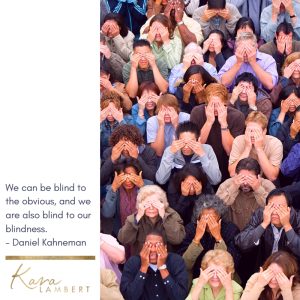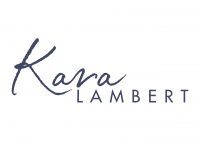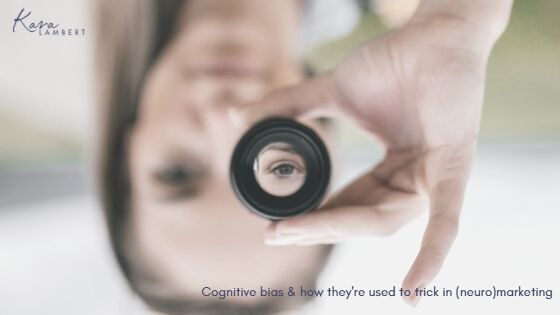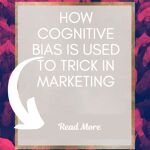While neuromarketing is a relatively new term, using cognitive bias in marketing is not a new practice. While some business owners will believe that neuromarketing is “dirty” marketing, many will actually not be aware that what they believe is normal or best practice is actually using the cognitive bias of their audience through neuromarketing.
There are almost 200 cognitive biases and heuristics, heuristics are rules-of-thumb that can be applied to guide decision-making based on a more limited subset of the available information, that people use in their decision-making and behaviour. I’ve gone through them and have identified ten that are readily used in marketing as part of neuromarketing.
The following cognitive biases and heuristics have a definition and how they are commonly used in marketing and neuromarketing. I have previously written two articles on neuromarketing in pricing and you can read more about that in this article on how odd and even ended prices impact sales or this article on how 9-ending pricing influences sales.
So which biases have I identified:
– anchoring bias
– availability cascade
– bandwagon effect
– choice-supportive bias
– confirmation bias
– end-aversion bias
– herd instinct
– ingroup bias
– rationalisation
– Von Restorff effect
Definitions have been gathered from the American Psychological Association Dictionary at https://dictionary.apa.org/
Anchoring bias
Definition: Anchoring bias is the tendency to form a belief, perception, or judgement when uncertain based on the first piece of information we receive be it information, the starting value, or initial judgement.
Example: A product or service is presented at a cost of $400 and the client believes that it’s too expensive, a similar product or service is presented at a cost of $300 will be seen as cheap based on the initial $400.
Example: Discount pricing where two pricing points are given on a website, the most expensive is placed on the left (in cultures that read left to right), or as the first presented price, and then other and the preferred option for the business is put next to it.
Use this bias: The anchoring bias is used on sales pages, shops (including online), and in other sales marketing.
Availability cascade/heuristic
Definition: Making judgments about the likelihood of something occurring based on their memory of something happening in the past and the availability of information about the same thing happening around them, such as on social media.
Example: A client believes that a business will run a discount or sale campaign because they have in the past and other businesses are running discounts or sales campaigns.
Example: A lead believes that a product or service is a good purchase because they see posts and ads for a particular product or service online.
Use this bias: This availability heuristic is most easily activated with retargeting ads.
Bandwagon Effect
Definition: the tendency for people in social and sometimes political situations to align themselves with the majority opinion and do or believe things because many other people appear to be doing or believing the same.
believe things because many other people appear to be doing or believing the same.
Example: A client is presented with an ad for a product or service saying that they have “millions sold”, “join our thousands of happy customers”.
Example: A customer sees their friends adding frames to their profile pictures to say that they have voted, been vaccinated, supported a cause, bought a product and they believe that they should do the same.
Example: A customer is on an eCommerce site looking to purchase. The site tells them how many other people are looking at the same item and who has just purchased what item.
Use this bias: The bandwagon effect is best used where you want to elicit a Fear of Missing Out (FOMO) through social pressure. Place multiple pieces of social proof on sales pages, use them in your social media posts, or label products or services that are your most popular as the most popular.
Bonus: Read this article on social proof.
Choice-supportive Bias
Definition: once a decision is made, there is a tendency to focus on the benefits of the decision and minimise the flaws.
Example: A client is asked to provide a review of the product or service they bought shortly after the purchase is made will be more positive than if they provided a review days or weeks later.
Use this bias: Automate an email asking for a client review to be received within a few hours of a client receiving a service, downloading a product, or receiving an item.
Confirmation Bias
Definition: the tendency to gather evidence that confirms pre-existing expectations, typically by emphasizing or pursuing supporting evidence while dismissing or failing to seek contradictory evidence.
Example: A client has decided to purchase a product or service after going to an eCommerce site. They then look for reviews and see ads on their social media, reinforcing their decision to purchase.
Use this bias: A confirmation bias is best activated through retargeting ads to people who have visited your website.
End -Aversion Bias
Definition: the tendency for individuals to avoid the choices at either end of a scale or number of options given side-by-side and instead select a choice in the middle of the scale.
Example: On a sales page, a lead chooses the middle pricing option of the three available.
Use this bias: Place the pricing option you most want leads to choose in the middle of a selection.
Herd Instinct
Definition: a drive in nonhuman animals to congregate in flocks and in humans to form social groups.
Example: A business sets up a Facebook Group for their customers to provide support and community around their offer.
Example: A business sets up a Newsletter list and tells subscribers to “join the tribe to get exclusive offers”.
Use this bias: This bias is best used to gain subscribers to a newsletter list or to join an online group and develop their affinity with the brand.
Bonus: Read more on why affinity benefits sales.
Ingroup bias
Definition: the tendency to favour one’s own group, its members, its characteristics, and its products, particularly in reference to other groups. The favouring of the ingroup tends to be more than the rejection of the other groups outside (outgroup), but both become more pronounced during periods of intergroup contact.
groups. The favouring of the ingroup tends to be more than the rejection of the other groups outside (outgroup), but both become more pronounced during periods of intergroup contact.
Example: A client buys a product and joins the company’s Facebook group. The owner of the Facebook Group continues to offer a variety of products to the group and they buy from the group owner over a competitor.
Example: A competitor makes defamatory remarks against the group’s owner or offer, the group will publicly defend the group owner or even criticise the competitor.
Use this bias: Use this bias to boost sales of your items within your followers, either through some online group or newsletter.
Rationalisation
Definition: Rationalizations are used to defend against feelings of guilt, maintain self-respect, and protect oneself from criticism.
Example: A client purchases an item and uses a number of arguments, social proof, and other rationalisations to remove any sense of guilt and to convince themselves (and others) to protect themselves from criticism regarding their purchase.
Use this bias: Frequently Asked Questions and social proof on sales pages provide a variety of rationalisations to support their purchasing decision.
Von Restorff Effect
Definition: the finding that people tend to have superior memory for odd or unusual information.
Example: Most of the words in a list are printed in blue ink, one word printed in red will be better remembered than the blue words
Use this bias: Use a different font type, style, or colour to highlight the price or feature of an item on its sales page.
I hope you now see how neuromarketing is used in very standard sales and marketing practices. These are only a few examples and there are many more ways we can use cognitive bias through neuromarketing to attract, engage, and convert our audience.
Further resources:
– how odd and even ended prices impact sales
– how 9-ending pricing influences sales
– the psychology of engaging social media content
– understand the psychology of your audience
– propaganda on social media
– use the psychology of reviews to improve your social media marketing
If you would like to discuss the specific psychology of your audience, please book a time for a free initial consultation.



[…] Cognitive bias and how it’s used in (neuro)marketing […]
Thank you for linking to this article as a reference.